Art Fairs
8 of the Best Artworks to See at the ADAA Art Fair, From a Supernatural Alice Neel Painting to Zanele Muholi’s Latest Portrait Series
We perused the booths to highlight the most impressive stands in the fair.
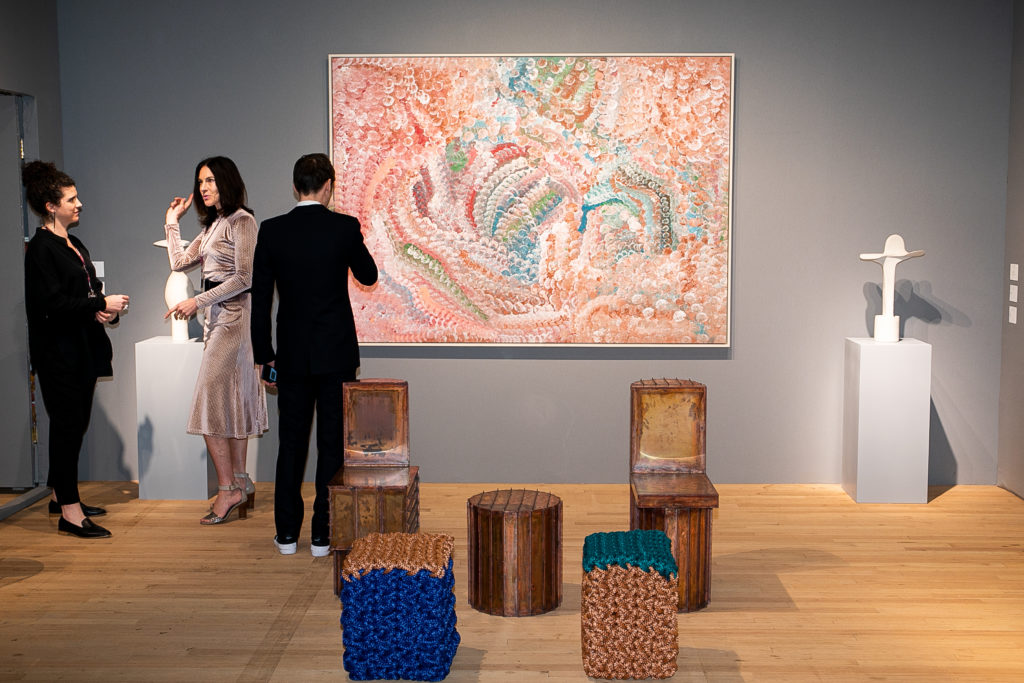
We perused the booths to highlight the most impressive stands in the fair.

Sarah Cascone &
Eileen Kinsella &
Tim Schneider

The opening night gala of the Art Dealers Association of America’s (ADAA) art fair attracted the usual crowds of well-heeled Manhattanite connoisseurs and international tastemakers alike.
Whereas the floors of the 67th Regiment Armory on Park Avenue are typically covered in gray carpet for the crowds of art lovers, this year’s edition featured the building’s newly renovated hardwood floors, lending a sleeker and more modern vibe to the storied show.
If the fair lacked some of the celebrities and typical boldface names that characterized past editions, this time around, there was no shortage of high-profile museum curators, collectors, and artists whose own work graced the surrounding booths. We spotted Nina Chanel Abney, KAWS, Kalup Linzy, Adam Pendleton, and Donald Moffett, to name a few.
Could all of this have translated into a more serious audience in our Instagram-obsessed society?
“Look around… no one is taking selfies,” P.P.O.W. co-founder Wendy Olsoff told Artnet News, noting the engaged, interested crowd of onlookers. Perhaps shockingly, her assessment was true, even considering the crowds descending on the gallery’s booth for a solo show of work by California artist Ramiro Gomez, who was in attendance (and in demand) at the booth.
Early sales reports, delivered just hours into the opening, indicated a strong response to the works on offer, including Pace Gallery reporting a sellout of their solo booth of text paintings by Adam Pendleton.
Here are a few more works you don’t want to miss.
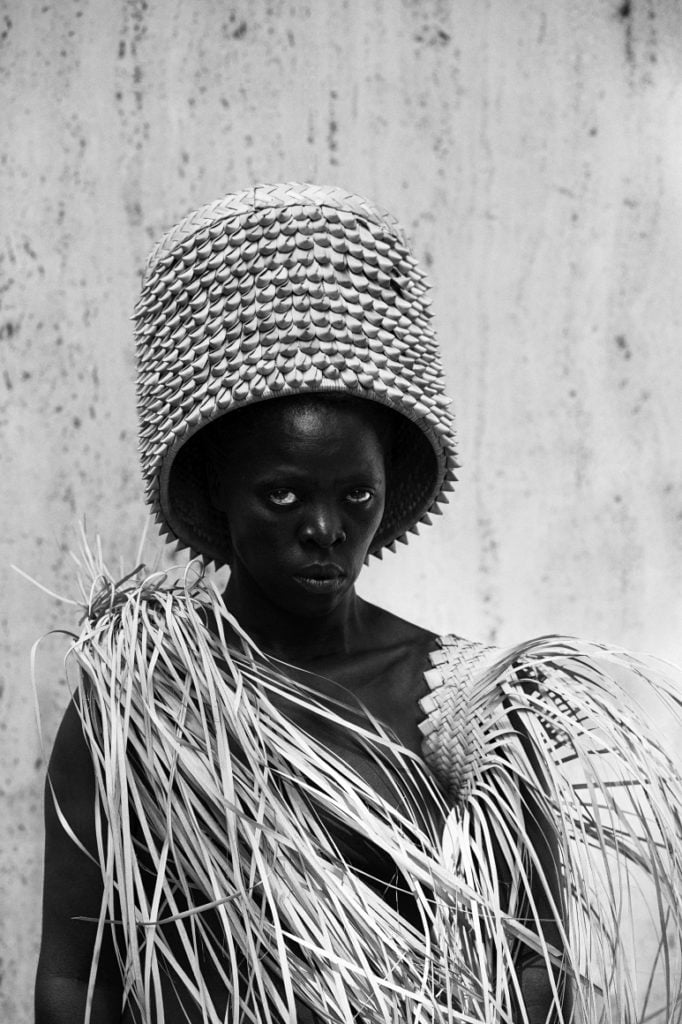
Zanele Muholi, Ziphi Emhlabeni (2019). Photo courtesy of Yancey Richardson.
Booth: Yancey Richardson Gallery, New York
What It Costs: $14,500 (each, in an edition of eight)
Why It’s Special: For the past several years, South African artist and photographer Zanele Muholi has been creating self-portraits in various locations throughout the world as a means of addressing issues of race, gender, personal history, and African political history.
Recent portraits on show here, including works made in formerly colonized countries such as Namibia, Botswana, and Zimbabwe, continue her efforts in that series. While bearing witness to the history of European imperialism in Africa, Muholi marks their presence in these locations, reclaiming their space.
—Eileen Kinsella
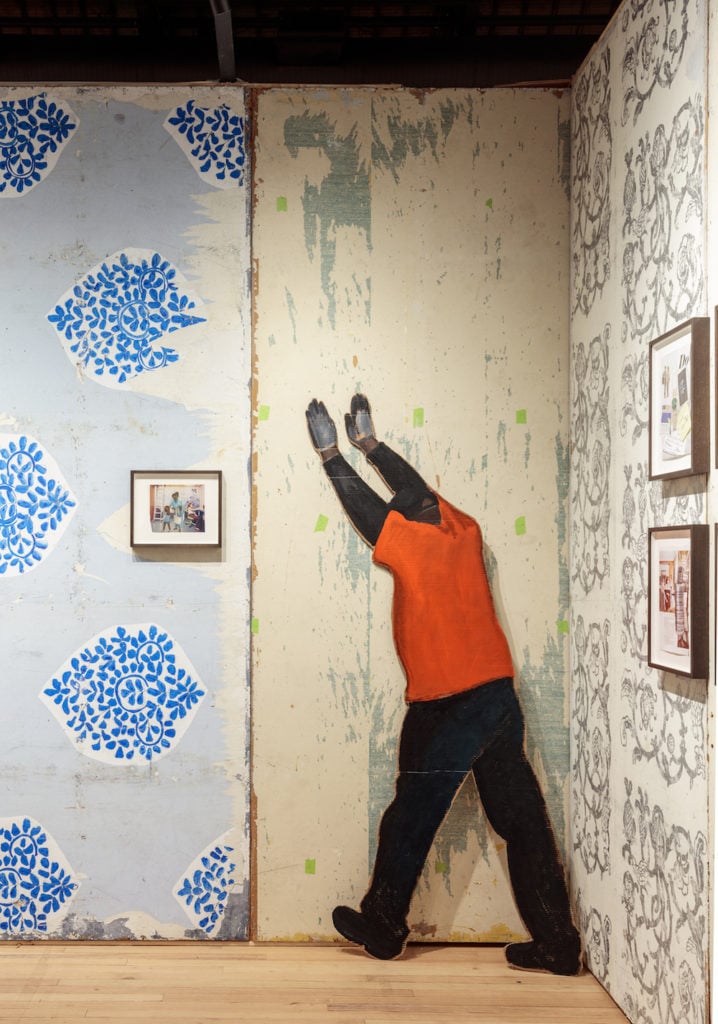
Installation view of Ramiro Gomez Installer 4(2020) at P.P.O.W. at the ADAA Art Show. Image courtesy of the artist and P.P.O.W Gallery.
Booth: P.P.O.W. Gallery, New York
What It Costs: $6,500–25,000
Why It’s Special: Gomez, who was born in San Bernardino to undocumented Mexican immigrants, focuses on the invisible labor forces devoted to maintaining those distinctive looking pools, gardens, and mansions in Southern California. Artnet News has been following his signature works for the past few years at fairs and gallery shows (including at P.P.O.W. and the gallery of Los Angeles dealer Charlie James) in which he’s been showing serene Hockney-esque images where workers who maintain lavish properties are not-so-subtly acknowledged. A bonus? Gomez himself was on hand in the booth last night to greet eager viewers and fans (including us). We asked what’s different about tonight’s presentation, which included more immersive pieces, as well imagery imposed on high-end architectural and home decor magazines.
“I love to keep expanding and not give the expected,” the artist said. The same magazines that were prevalent in the homes where he was employed (Town and Country and Architectural Digest, to name two) are the ones that have now featured him—an irony not lost on him. After briefly attending the California Institute for the Arts, he worked as a live-in nanny in West Hollywood. These works take on additional layers of “representations of internal fantasies, dreams, and expressions of the self,” according to the gallery.
—Eileen Kinsella
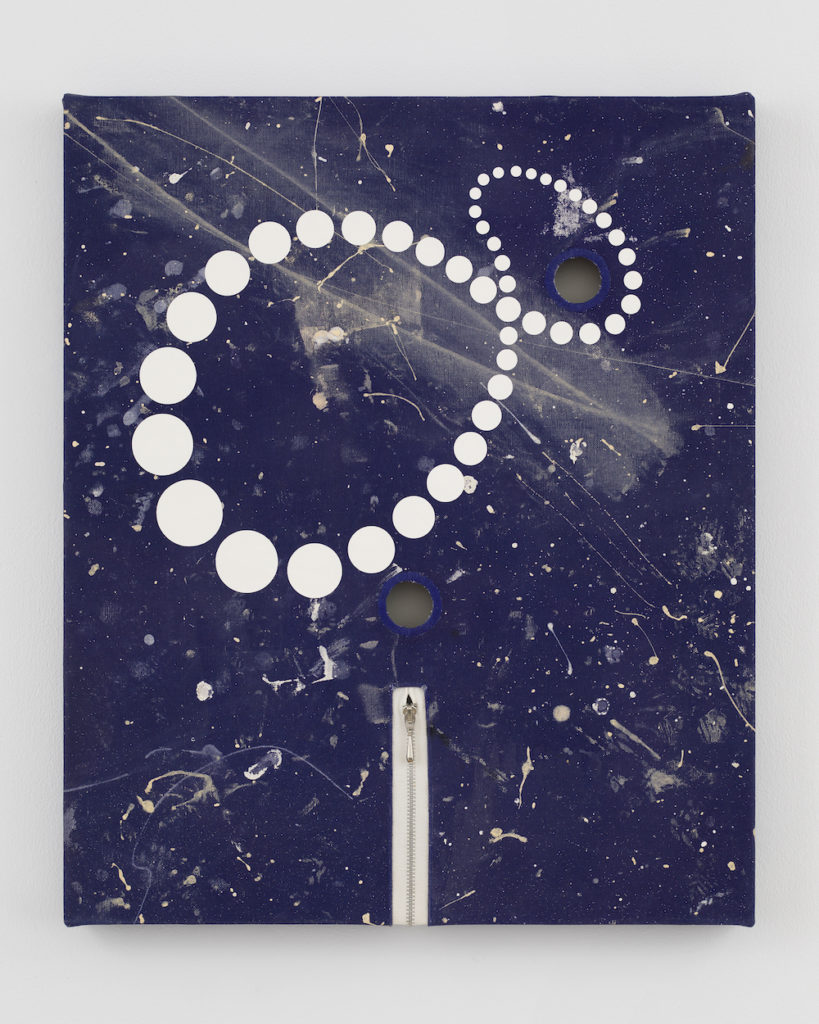
Donald Moffett, Lot 021007/20 (OO, night loop) (2007/2020). Image courtesy the artist and Marianne Boesky Gallery.
Booth: Marianne Boesky Gallery, New York and Aspen
What It Costs: $110,000
Why It’s Special: Marianne Boesky devoted her booth to a series of mixed-media works, titled Fleisch, that Donald Moffett first started working on in 2007 and returned to recently. The resulting display is both quiet and dazzling.
“Fleisch is the German word for our English half-rhyme flesh, which designates the meat and fat between skin and bones, as well as, figuratively speaking, carnal needs or appetites,” art historian Kate Nesin writes in a catalogue essay accompanying the show.
Moffett’s works “can at first appear all skin and bones… barely painted, though their stretched linen expanses have been sized,” according to Nesin’s essay. Marianne Boesky pointed out the multiple additional symbols and marks—like tear shapes—and metal zippers that emphasize the connection between painting and the body. The compositions are “provocative and poetic, serving as an implicit form of social critique of the body politic,” she said.
On Sunday, March 1, the artist will be participating in the fair’s “Meet the Artists” event, where he will be registering voters at the booth from 12 p.m. to 3 p.m. Keep an eye out for Moffett’s limited-edition sticker encouraging people to vote.
—Eileen Kinsella
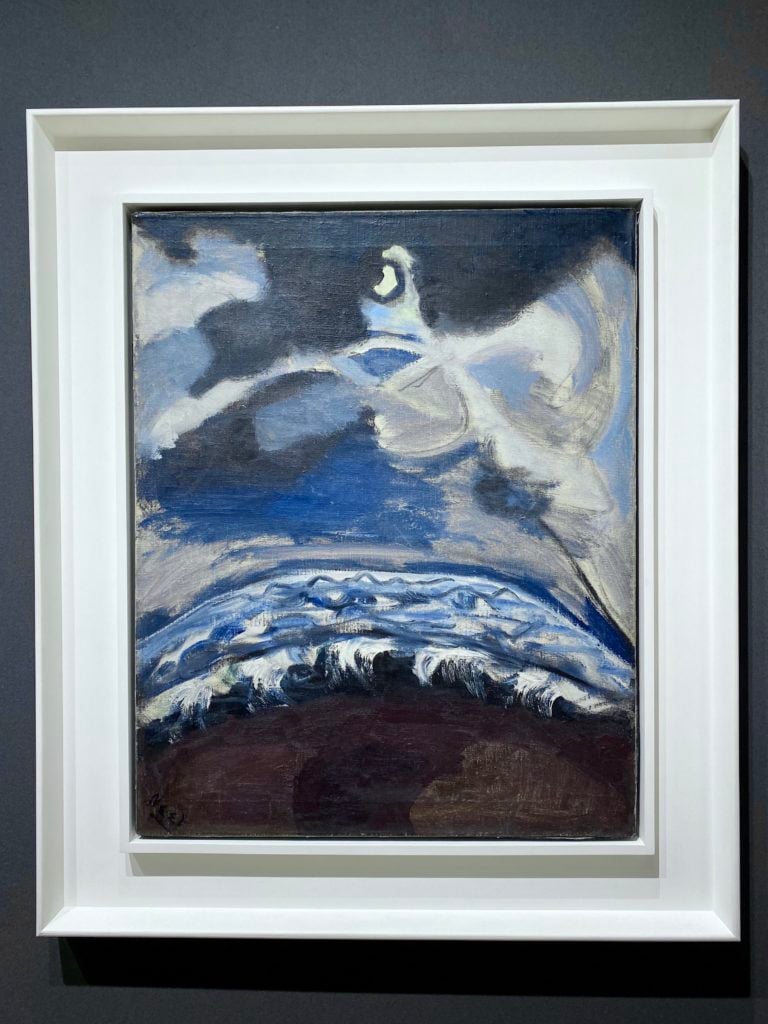
Alice Neel, The Sea (1947). Photo by Tim Schneider.
Booth: Cheim & Read, New York
What It Costs: $450,000
Why It’s Special: Although Alice Neel is rightfully renowned for her evocative portraits, her practice had a wider scope than most realize. Cheim & Read’s solo presentation of the artist’s work includes multiple renditions of urban environments and this roiling, figure-free marvel of the coast.
Gallery cofounder John Cheim defines The Sea as a “pantheistic nature painting”: look closely, and you can see eyes in the surf and faces in the sky above. Neel claimed she painted the work from memory after taking a solo walk along the Atlantic Ocean to clear her head upon learning of her father’s death. Channeled through her usual virtuoso brushwork, the complex emotions stoked by her loss infuse the turbulent seascape with an elemental power—one that Neel enhances further by bending the horizon into a crescent, as if grief had torqued the natural world into some alien planet.
—Tim Schneider
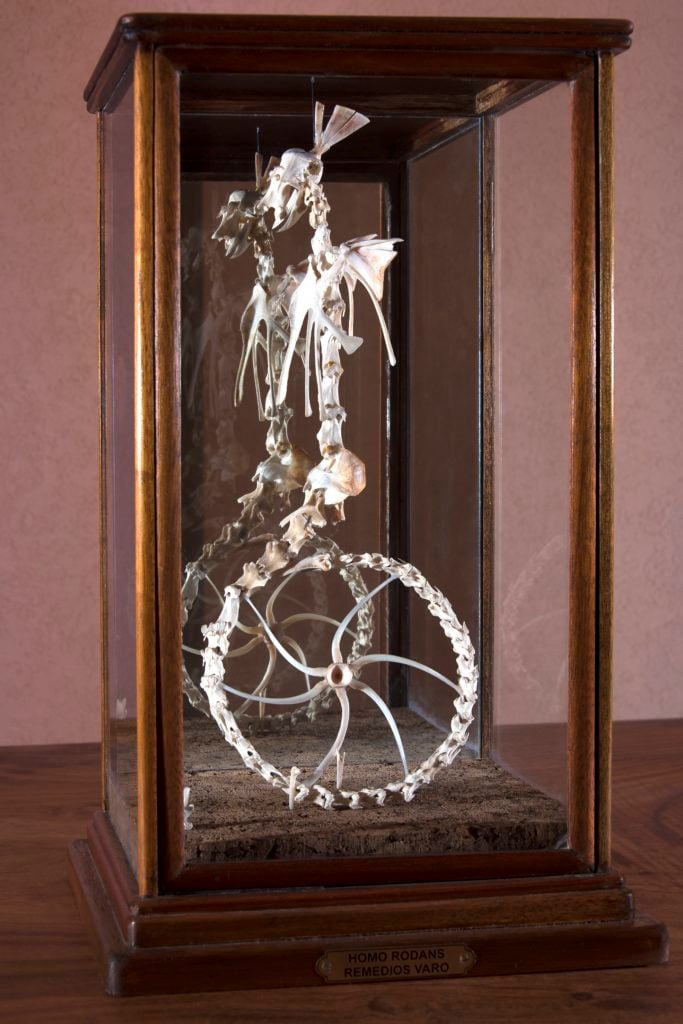
Remedios Varo, Homo Rodans (1959). © 2020 Artists Rights Society (ARS), New York / VEGAP, Madrid. Photo by Rafael Doniz, courtesy Gallery Wendi Norris, San Francisco.
Booth: Gallery Wendi Norris, San Francisco
What It Costs: $2.5 million (available only to institutions)
Why It’s Special: Homo Rodans carries the distinction of being the only surviving three-dimensional work by the gone-too-soon Spanish Surrealist Remedios Varo, who died in 1963 at just 54 years old.
Wired together from chicken, turkey, and fish bones saved from meals with friends, the sculpture purports to be the extant skeleton of a species called Homo rodans, an overlooked predecessor to Homo sapiens that sported bat-like wings and a large wheel in place of legs.
Accompanying the sculpture is a stunning illustrated manuscript in which Varo adopts the character of a fictional German anthropologist named Hälikcio von Fuhrängschmidt, who argues for a rewriting of evolutionary history to account for this preposterous creature.
“She wanted to imbue her love of myth into science,” says dealer Melanie Cameron. The result is a tongue-in-cheek masterpiece that stretches across genres, from assemblage to illustration to meta-fiction.
—Tim Schneider
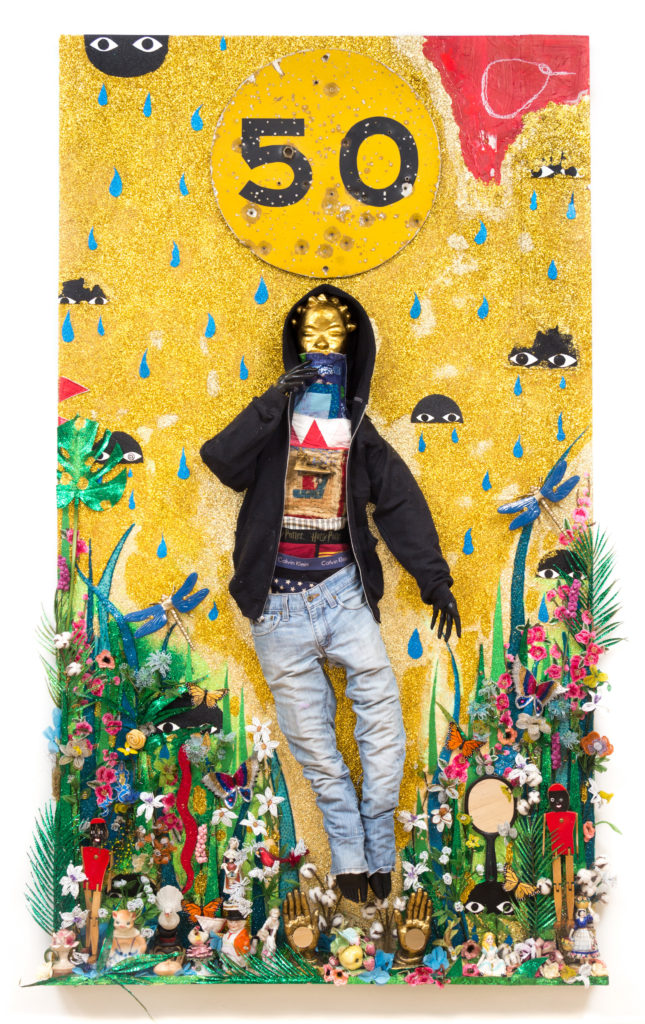
Vanessa German, FLY BOY or HOMO GALACTICUS IN FLIGHT (2020). Photo courtesy of Pavel Zoubok Fine Art.
Booth: Pavel Zoubok Fine Art, New York
What It Costs: $60,000–75,000
Why It’s Special: Vanessa German’s eye-catching mixed media assemblage works, made from all manner of found objects—plus blown glass from a recent residency at New Jersey’s Wheaton Arts Glass Museum—offer a poignant response to racism, violence, and homophobia.
The self-described “citizen artist,” who has transformed her Pittsburgh home into a community art program for local children, has recently been dealing with the suicide of a young boy in her neighborhood—but German wasn’t that shocked by the tragedy. “Nobody lets little black boys cry. Nobody lets little black boys be in love with little black boys,” she told Artnet News at the fair. “I’ve been thinking about what the cost is when you make a world that is too sharp for fragile humans to be whole inside of.”
German, who is self taught, plans to expand her community outreach by opening a new artist residency at her home. In a take on Kehinde Wiley’s Black Rock Senegal, hers will be called Amethyst Pebble, because “it’s super small, and I’m thinking about art and healing,” German explained. “I don’t have the luxury to not be an activist.”
—Sarah Cascone
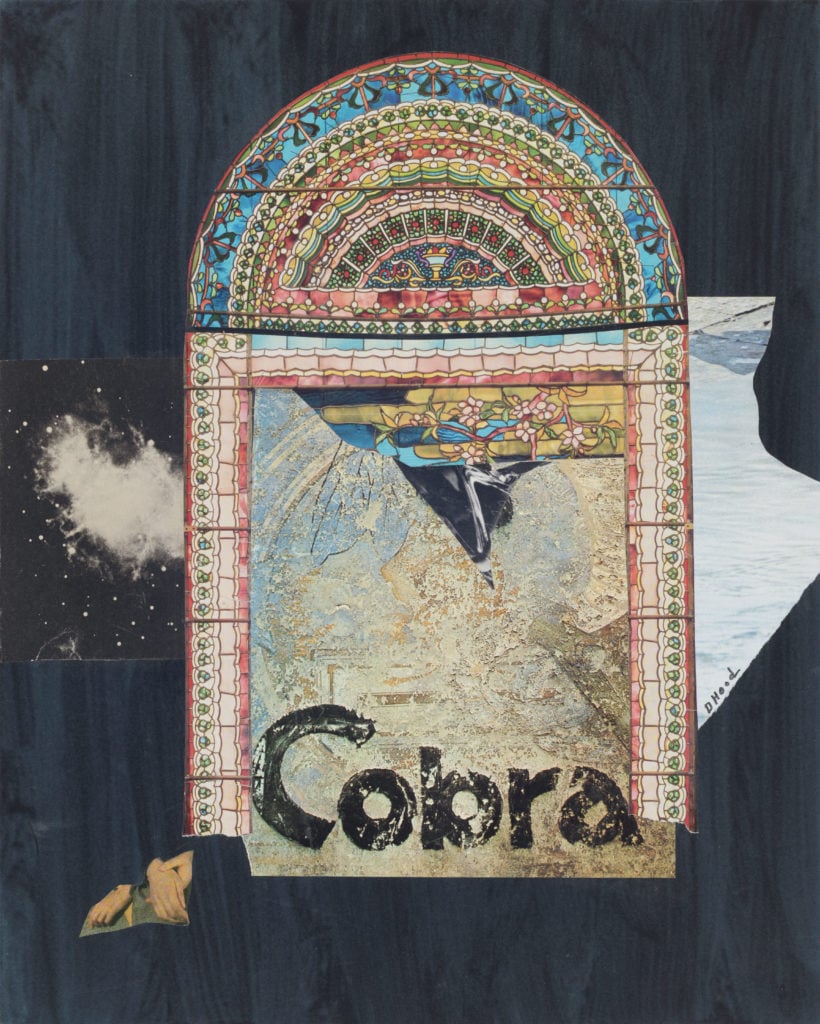
Dorothy Hood, Untitled (074), circa 1980s or ’90s. Photo courtesy of McClain Gallery, Houston.
Booth: McClain Gallery, Houston
What It Costs: $11,000
Why It’s Special: Dorothy Hood (1919–2000) “is sort of a cult figure in Texas,” gallery director Erin Dorn told Artnet News. A Rhode Island School of Design graduate, Hood was a Modernist painter who spent 20 years in Mexico, where she was mentored by José Clemente Orozco and became friends with the likes of Frida Kahlo, Diego Rivera, and poet Pablo Neruda.
Her work, said Dorn, “is kind of born of the Mexican Surrealist movement and European abstraction all at once.” McClain is highlighting her later collages, which incorporate fragments of her old, cut up paintings, as well as printed materials.
But despite the work’s aesthetic appeal, “she’s one of those artists who’s a little bit behind the market,” Dorn added, noting that before an exhibition at the Art Museum of South Texas in 2016, “generally the work hadn’t been seen for about 30 years.”
—Sarah Cascone
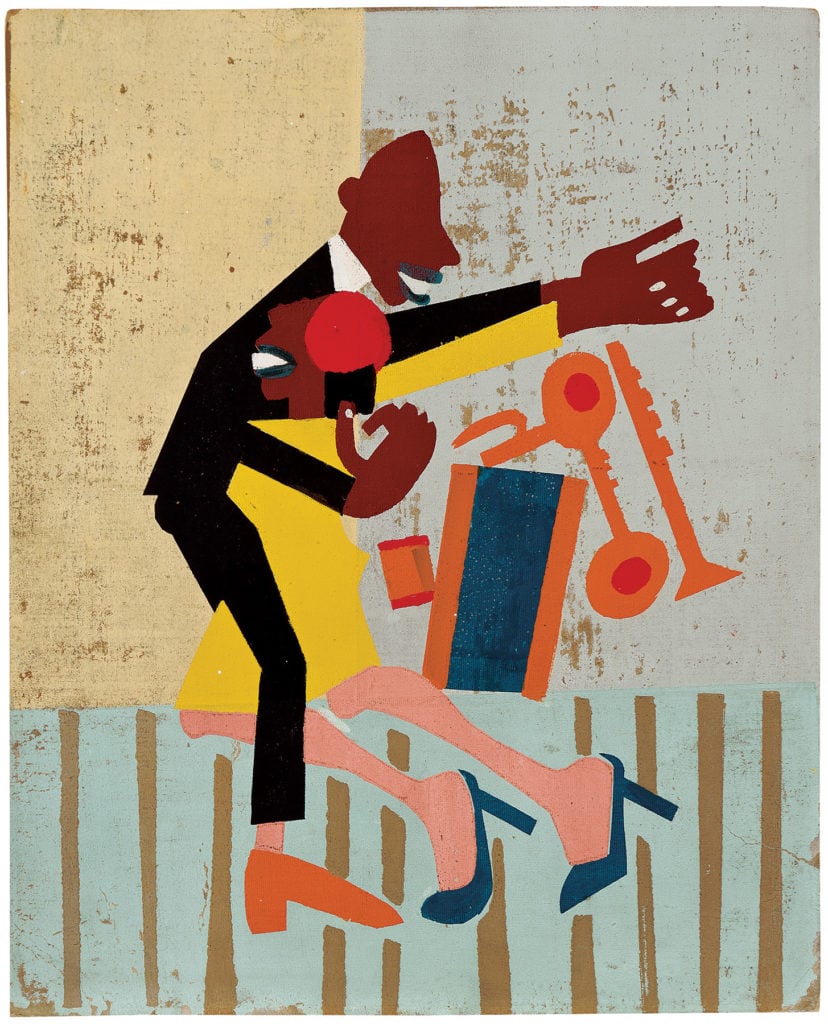
William Henry Johnson, Jitterbugs (II), circa 1941. Courtesy of Michael Rosenfeld Gallery, New York.
Booth: Michael Rosenfeld Gallery, New York
What It Costs: $200,000
Why It’s Special: Before he was stricken with mental illness in his 40s, William H. Johnson (1902–1970) had an impressive art career as an African American painter who lived and worked in Europe, eventually abandoning more conventional expressionist landscapes to depict scenes of African American life in a self-described “primitive” style.
In a solo booth dedicated to the artist, Michael Rosenfeld Gallery presents work from both periods of Johnson’s career. The highlight is undoubtedly the later work, stenciled pochoir prints that bring to mind the work of Jacob Lawrence. His mastery of color and form sings in Jitterbugs II, a composition of a couple dancing shown here two times, printed once on newsprint and again on poster paper.
The gallery staged its first and only exhibition of the artist’s work back in 1995. “His work is so incredibly rare,” director Halley K. Harrisburg told Artnet News. “Since then, we’ve been squirreling away any other pieces in order to do another show.”
The booth was doing brisk sales—six of the 14 works had already sold on night one, with “tremendous museum interest,” said Harrisburg. “He is one of the great 20th century American Modernists, and for collectors to have an opportunity to have a choice [of Johnsons] is extraordinary.”
—Sarah Cascone